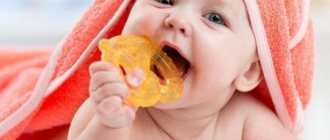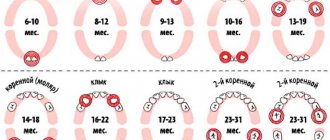We will talk about canines - powerful single-rooted teeth with serial number 3, located in pairs in the upper and lower jaws between the front incisors and premolars. The term “eye teeth” appeared in parallel as a common one, primarily among dentists themselves. There is even a diagnosis of “eye tooth”, and it is made by doctors when the child’s fangs begin to grow, accompanied by a distinct pain syndrome.
Because the roots of these teeth are located in close proximity to the facial and optic nerves, this growth may be accompanied by pain in the eyeballs. And the removal of such a tooth is also fraught with unpleasant sensations in the eye area. True, rumors that you can go blind after surgery related to these teeth have no basis.
Among non-specialists, the name “eye teeth” is used due to the fact that if you mentally continue the axis of such a tooth upward, it will pass right along the corner of the eye, which can be seen by stretching your lips and exposing your fangs in a grin.
Eye teeth are just fangs
Yes, the truth is precisely that “eye teeth” are nothing more than ordinary fangs, which are present in the same quantity as in the primary occlusion, i.e. in a child, and permanently in an adult. They are located on the upper and lower jaw between the incisors and molars (two units above and two units below). Dental experts call them “threes.” These teeth are single-rooted. Those on top “crawl” through the jawbone a little earlier than their lower counterparts.
The approximate timing of eruption for eye teeth is in the primary dentition of a child from 15 to 20 months from birth (from about one and a half years), in the permanent dentition - from 8 to 10 years.
Now you understand that “eye teeth” are not at all some pathological elements of the dentition. And their appearance is considered a natural process for absolutely all people on earth and is not at all associated with deviations or anomalies in development. In appearance, the fangs also do not look scary; they have a pointed shape towards the bottom (they are more elongated than the neighboring incisors), which helps us literally “cut off”, tear off and bite off food. Look at the photo - this is exactly what they look like.
In the photo you can clearly see the difference between ordinary incisors and canines
What teeth are called eye teeth?
Eyeteeth is a folk term, not a medical one. In common parlance, this is usually what the upper canines are called, and by analogy with them, the lower ones too.
Probably, the fangs received their special name due to the fact that next to them there are branches of the facial nerve, when irritated, severe pain occurs, spreading to the upper half of the face and radiating into the eyes. That is why, when a child develops baby eye teeth, it is accompanied by excruciating pain and other unpleasant symptoms. And because of this, removing fangs in adults is a very painful procedure that requires serious anesthesia.
Despite their name, eye teeth do not affect vision in any way. Although quite often dental patients express the opinion that if a fang is removed they can easily go blind, such a prejudice has no medical evidence and is erroneous.
Eruption of canines affects the optic nerve
Although the fangs are single-rooted, their roots are longer than those of their neighbors. Due to its anatomical location and structure of the maxillofacial system, it affects the ocular and facial nerves. Namely, the facial nerve, in turn, is responsible for transmitting impulses from the central nervous system of our body to the upper part of the face. That is why, during their eruption, such teeth can cause a lot of discomfort in the baby and even pain in the eyeballs. Now do you understand why these units are popularly called “ocular”?
Branching of the trigeminal nerve
Symptoms
Cutting a child's teeth is quite painful. The first signs of this phenomenon:
Do baby teeth hurt?
- increase in body temperature (hyperthermia can persist until all 4 fangs are “born”);
- nasal congestion;
- restless, capricious, whiny behavior, loss of appetite;
- insomnia;
- redness, swelling, soreness (symptoms of an inflammatory process) of the gums where the upper or lower gums are cut;
- diarrhea (increased gas formation in the intestines);
- immune failure;
- conjunctivitis (inflammation of the eyelids), excessive lacrimation.
It is important to understand that severe, constant pain in the mouth can indicate a wide range of dental problems (for example, indicate gumboil, periodontitis, etc.). That is why, in case of severe eruption of permanent fangs, it is recommended not to self-medicate, but to seek help from a doctor.
Eruption of eye teeth is difficult and painful
We all know that during the period of primary teething, our babies need special attention and approach. Often this period of time causes a lot of concern among parents due to the child’s capriciousness, the desire to put foreign objects into the mouth and bite, loss of appetite, and the appearance of other warning symptoms: diarrhea, runny nose and cough, increased body temperature. But it is acute painful sensations that most often accompany the appearance of “eye teeth” in children.
If during this period of time an infection is added to all the above symptoms, which attacks the baby’s weakened body, exhausted by such stress, then not only the mucous membrane surrounding the future tooth may become inflamed, but also the optic nerve. As a result, the eyes will become sore, conjunctivitis will appear, the baby will begin to react poorly to bright lighting, and tears will also flow heavily.
The eruption of such teeth can cause a lot of discomfort in the baby and even pain in the eyeballs.
What other symptoms can increase significantly during the period of eruption of “eye teeth” in a child (compared to other units):
- body temperature almost always rises: the high temperature in this case can last longer than expected - not 2-3, but sometimes all 3-5 days,
- a cough and runny nose will appear: be careful here, because this sign may indicate not only an increased secretion of saliva, which often accumulates in the baby’s mouth and enters the nose when lying down, but also a possible weakening of the immune system and the development of ARVI against this background,
- Severe swelling and inflammation of the soft tissues occurs: if oral hygiene is improper during this important period, the baby may develop gingivitis.
Monitor your baby closely; in case of alarming symptoms (vomiting, persistent fever, diarrhea) or suspicion of ARVI, be sure to call a doctor. Otherwise, teethers, pacifiers (preferably orthodontic), antipyretics (Nurofen), anti-inflammatory creams and ointments like Kamistad Baby, Kalgel, adjusting the temperature in the baby’s room and eliminating any allergens ( dust, wool, plants). You can also use Viburkol suppositories to normalize the baby’s general condition and well-being.
Kamistad baby drug
“On the general symptoms of the eruption of “complex” teeth, which include “eights” (wisdom teeth) and “threes”, i.e. fangs, quite strongly affects the child’s immunity. If it is consistently strengthened from the very moment of birth, then in most cases, when babies erupt, they do not have problems such as upset stool, fever, or poor health,” says dentist-therapist N.G. Boyko.
How to ease the baby's suffering?
It is impossible to ensure completely painless eruption of eye teeth. However, you can help your baby in several ways.
A light massage of the gums slightly dulls the pain. In any case, this stops the kids from crying. To do this, you need to gently stroke the gum just above the eye tooth for a couple of minutes. This massage can be done two to three times a day.
Now pharmacies sell special teethers. Before using, keep them in the refrigerator for a while. These simple products are filled with distilled water. If the baby bites through the shell, then nothing bad will happen.
You can dull the pain with the help of anesthetic gels Dentinox, Kalgel or Kamistad. They begin to act a few minutes after application to the gums.
If the baby’s nose is stuffy during the teething of the eye teeth, then in this case it is worth using drops of Otrivin, Nazivin or Quix. They tend to constrict blood vessels. It also happens that the body temperature of babies rises to 38 degrees or higher. In this case, you have to resort to antipyretic children's drugs paracetamol or ibuprofen. They are available in the form of syrups or candles.
If the baby is having too much trouble with the teething of the eye teeth, then in such a situation it is better to call a pediatrician at home.
“Eye teeth” are resistant to destructive processes
“Eye teeth” in both children and adults are considered one of the strongest, even though they are of the same root. All this is due to their shape, smoothness, absence of pits and depressions on the surface, as well as a fairly thick layer of dentin. They are rarely susceptible to caries or other damage, but this does not mean that they do not need care. Even the very first units that erupt should be cleaned using special wipes and silicone finger brushes. As your child grows, teach him how to independently use a soft-bristled brush and non-abrasive paste for oral hygiene. And remember, if there are bacteria in the mouth, then sooner or later even the fangs will not withstand their pressure.
It is important to teach your child oral hygiene from early childhood.
The eye units in some children grow crooked or occupy an incorrect position on the jaw, “climbing” onto their neighbors. Previously, in such a situation, doctors suggested removing them, but today the problem is successfully solved by orthodontists and devices that correct the bite.
Features in adults
Although eye teeth tend to be more of a concern for young children, adults also often have questions related to some type of canine problem.
- At what age does the replacement of primary canines with permanent ones occur? Typically, the eye teeth on the upper jaw appear a little later than on the lower jaw. The approximate age when the lower canines grow is 9-10 years, and the upper ones are 11-12 years.
- How many permanent eye teeth appear and can they erupt before the front teeth? The canines appear fifth in the permanent dentition - after the first molars (5-6 years), central and lateral incisors (6-9 years), and first premolars (10-12 years). Violation of this pattern of eruption of permanent teeth can be both an individual characteristic of a person and a sign of serious dental pathology (for example, adentia due to the death of the rudiments of permanent teeth).
- Why can an eye tooth hurt? Normally, a healthy person should not have any pain in the teeth. If the eye tooth still hurts, then this may be a sign of a serious pathology: periostitis (flux), pulpitis, periodontitis and others. In any case, you should not engage in independent treatment - it is better to consult a dentist for qualified help. The only thing you can do before visiting the doctor is take a pain reliever.
- What to do if the eye tooth has grown incorrectly? Dental anomalies in the form of crooked teeth are quite common. In some, this defect is practically invisible, but sometimes the fangs erupt at a considerable distance from their intended place. This situation can be corrected by orthodontic treatment (braces, mouth guards), but sometimes, in especially severe cases, the doctor suggests pulling out a crooked tooth to straighten the dentition.
- Is it possible to remove eye teeth? Removing any tooth is an extreme measure that the dentist will only take as a last resort. And fangs are no exception to the rule. Premature loss of a baby eye tooth can lead to the formation of malocclusion, and its removal in an adult significantly impairs the chewing function of the teeth and also negatively affects a person’s appearance. But if you still had to pull out a fang, then you should have it prosthetically installed as early as possible.
While the eye teeth are special, the importance of the rest cannot be underestimated. It is necessary to carefully monitor the condition of the oral cavity - only this will help maintain a healthy and beautiful smile until old age.
Removing eye units is challenging
Not only teething, but also the removal of fangs, and even their absence, cause certain difficulties. For example, the procedure for removing fangs itself is considered quite difficult; after it, severe swelling, pain, the development of an inflammatory process, and even deterioration of vision are possible if the optic nerve is damaged (due to traumatic removal or complications during the recovery period after the procedure). And the absence of “eye teeth” and their untimely restoration can make it difficult to pronounce certain sounds, which will impair diction and speech.
Removing fangs is a rather complicated procedure.
Also, do not forget that the fangs are located in the frontal zone of the smile, so their absence will directly affect the aesthetics of the entire face. In addition, it is the canines that serve as excellent support for the orbicularis oris muscle; if they are missing, the muscle around the mouth will become flabby and increase age.
Notice
: Undefined variable: post_id in
/home/c/ch75405/public_html/wp-content/themes/UltraSmile/single-item.php
on line
45 Notice
: Undefined variable: full in
/home/c/ch75405/public_html/wp-content /themes/UltraSmile/single-item.php
on line
46
Rate this article:
( 3 ratings, average: 5.00 out of 5)
prevention
Consulting specialist
Chorny Stanislav Vladimirovich
Doctor rating: 9.8 out of 10 (4) Specialization: Orthopedist Experience: 20 years
Permanent fangs
At the age of 7 to 9 years, baby fangs begin to change into “adult”, permanent ones, which a person will have for the rest of his life, under conditions of appropriate care and the genetic predisposition of the teeth to longevity. Fangs very rarely suffer from caries or any other pathologies.
Undesirability of deletion
The inconsistency of rumors about possible blindness after removal of fangs, especially the upper ones, is written above. An exception is the pathology of the development of the canine and its root, when the optic nerve can come into contact with the nerves of the canine root. Then careless extraction, disrupting the canal of the optic nerve, can cause one-sided blindness on the half of the face where the extraction took place. To avoid this, be sure to take an x-ray of the roots and jaw. The resolution of X-ray machines in dental clinics makes it possible to examine and recognize pathology so that subsequent surgery can proceed without complications. And a consultation with an orthodontist and an orthopedic dentist is required to look for opportunities to save the tooth.
Fangs play a big role in pronouncing individual sounds, so removing either the upper or lower eye teeth can lead to a decrease in the quality of diction.
When the dentition is deprived of fangs, whose main function is tearing and tearing solid food, their “duties” begin to be performed by the incisors and, to a lesser extent, premolars (teeth No. 4 and 5). This means that the load on these teeth increases.
Comments
My fangs stick out terribly, they seem to be incredibly long, like a vampire's, sticking out and pushed forward. I don’t like it, I’m embarrassed to smile because of them. Tell me, is it possible to somehow correct the situation, maybe file them down?
Marina (01/20/2019 at 08:56 pm) Reply to comment
- Dear Marina. The most correct decision for you will be an orthodontist, who, based on your situation, will select the appropriate corrective device option. If the fangs are healthy, then there is no need to file them down or put a crown on them, for example. Also, most likely it will not be possible to install a veneer, because... in case of significant deviations from the norm, this lining will not be able to solve the problem, and the tooth enamel will have to be greatly ground down, which is completely useless if it is healthy and intact. Consult with several doctors so that you can choose the best solution for your problem.
Editorial staff of the portal UltraSmile.ru (01/23/2019 at 08:24) Reply to comment
The article is useful for understanding those who do not know anything about eye teeth. And this is a simple explanation, fangs around the edges. Do I understand correctly that the eye teeth need to be removed if there is curvature of the fangs?
Peter (01/30/2019 at 08:29) Reply to comment
The child's eye teeth have erupted. How painful it is, I remember how it was when I was a child. Can fangs hurt from time to time and what do you recommend to do so that my daughter stops experiencing pain?
Raisa (01/30/2019 at 08:47) Reply to comment
I'm anxiously awaiting the baby's eye teeth. Two molars came out at the same time. Three days of fever and diarrhea. Viburkol suppositories do not help much. Maybe there are other candles so that they are also not very harmful?
Ekaterina (01/31/2019 at 14:04) Reply to comment
- Ekaterina, you should definitely contact your pediatrician. You can’t just choose candles based on useful tips posted on the Internet. For our part, we try to do only reviews of drugs, but we still insist that readers use them as prescribed by doctors. Especially when it comes to young children.
Editorial staff of the portal UltraSmile.ru (01/31/2019 at 14:21) Reply to comment
Recently, the child’s eye teeth began to appear. The child became restless. He doesn't sleep well at night. The temperature began to rise and diarrhea began. Well, for us it doesn’t last long, only three days.
Anastasia (02/12/2019 at 11:52 am) Reply to comment
Write your comment Cancel reply
Growing pains
At 9-12 years of age, the growth of eye teeth can cause temporary inconvenience and discomfort. And at the age of one and a half years, as the first baby fang moves apart the gum in its desire to grow outward into the oral cavity, this can cause serious suffering to the child. Crying at night, whims - this is a short list of what the parents of a baby have to endure, with whom some kind of meaningful dialogue has just begun to develop, who seems to have already learned to react “correctly”, from an adult point of view, to the environment - and here The relationship between an owl slides down to the level of a baby.
Moreover, disoriented by the confusion of day and night into which their child has been driven, parents may mistake the symptoms of eye teeth growing into something else. In eye disease, as often happens. Therefore, contacting a pediatrician should take place as early as possible.
In complicated cases, the child will be prescribed medications that significantly reduce swelling of the gums and relieve pain. These, after a medical examination and prescriptions, can be pain-relieving gels “Metrogil Denta”, “Kalgel”, “Kamistad”.
In adolescence, it is time to replace a baby tooth with a permanent one. It often happens that a well-fitting baby tooth does not want to leave its place and prevents the “adult” tooth from taking its place between the incisors and premolars. In such a situation, the canine may grow incorrectly, with a displacement inward, towards the tongue, or outward, towards the cheek, which will distort the bite and will not contribute to normal chewing of food.
Teeth are cutting!
A seven-month-old child has a fever, his nose is running, he refuses to eat... Is it really ARVI again? After all, you just recently got sick? Or maybe the child isn’t sick after all? But then where do these symptoms, typical of colds, come from?
You can read about the symptoms of ARVI in children here
Today, with Valeria Aleksandrovna Golovko, a pediatrician at Clinic Expert Tula LLC, we are talking about long-awaited teeth. How many months does the first tooth appear? What accompanies their appearance? Our article is about this and much more.
- The first thing parents expect from a child is a smile, then his “aha”, but the most exciting expectation is whether the baby will have teeth? When do babies' first teeth start to grow?
According to statistics, the first milk teeth appear on average at 6-8 months of age. As a rule, these are the middle lower incisors.
The onset of teething depends on a number of factors. From which ones exactly?
— heredity or, in other words, the timing of the appearance of teeth in the baby’s parents;
- full-term baby. Premature babies may develop teeth later;
- the child’s nutrition, namely, sufficient intake of calcium into the body (after the start of complementary feeding, the main sources of calcium are cottage cheese and somewhat less - kefir);
— sufficient intake of vitamin D into the body. Its natural sources are egg yolk and butter;
— climatic conditions. Children living in hot climates erupt teeth earlier;
- gender of the child. Girls erupt teeth earlier;
- sometimes a deviation in the period of teeth appearance from the statistical average in one direction or another occurs in situations where a baby has 1-2 teeth immediately after birth. They are usually always defective and quickly fall out or are removed.
- What is the pattern of baby teeth eruption in children?
First, the lower middle incisors appear (simultaneously or in turn). Then 4 upper incisors erupt, and then 2 lower lateral ones. On average, a baby has 8 teeth by the age of one year.
After this, the molars (premolar teeth) are cut. The lower anteriors appear somewhat earlier (at 12-18 months), and the upper anteriors appear later (at 13-19 months).
Then the rear molars appear: the lower ones - from 20 to 31 months, and the upper ones - from 16 to 22 months.
Canines: lower - from 16 to 23 months, and upper - from 16 to 22 months.
Those. By the age of 3, a child has 20 primary teeth, i.e. incisors, canines and molars.
Individual differences should also be kept in mind, i.e. this number of teeth can be at 2 or 2.5 years.
- Let's talk about the first signs of teeth appearing in a baby. What could they be?
One of the first manifestations is redness and swelling of the gums. Salivation increases. Appetite worsens, up to complete refusal to eat. Irritability increases and sleep is disturbed. The baby asks to be held more often, and physical activity increases. The reason is itching and sore gums.
- What painful symptoms can accompany the appearance of teeth in a child?
This is salivation, nasal congestion and discharge from it. Sometimes there is a cough/cough, stool disturbances in the form of loosening (but maintaining the normal frequency of bowel movements). There may be irritation of the skin of the mouth, chin, chest, i.e. areas where saliva enters. In some cases, the temperature rises: more often not higher than 38.5°C, less often - 39°C and higher, often subsides on the second or third day. The child may become irritable.
Vomiting and diarrhea are less common: in this case, you need to be especially vigilant, since these signs may not be associated with teeth, but indicate some kind of disease - for example, rotavirus infection.
What to do if your child has a stomach ache? The story is told by the surgeon, Deputy Chief Physician for Pediatrics at Clinic Expert Smolensk LLC Alexey Alexandrovich Zakharov
- How to relieve baby's teething pain?
This task is not easy. First of all, it is necessary to ensure that the baby has the opportunity to chew sufficiently. This is what teethers are designed for. Massaging your gums may help.
Gels are also used when teething in children, but their disadvantage is that they can cause an allergic reaction.
There are homeopathic rectal suppositories. According to indications, antipyretic and analgesic syrups can be used.
-Which teethers are best to use?
They must be elastic and durable (and therefore safe). The best ones are silicone, latex, having the appropriate anatomical shape to form the correct bite.
There are also plastic teethers that contain liquid or gel inside. Before use, they are cooled in the refrigerator (at +6°C) and only then given to the child. The additional cold factor also reduces pain to a certain extent. The downside is that these teethers need to be constantly cooled.
A separate advantage of teethers is their positive effect on fine motor skills.
-Can I use carrots, apples or cookies instead of teethers?
In principle, it is possible, but, firstly, these products should already be in the child’s diet; secondly, their use should not begin when the first teeth erupt: at least, all incisors should be present; and thirdly, the child must be able to swallow food well. If you give a teething child an apple, carrot or cookie, you must ensure that the child does not choke.
- How do you feel about using traditional methods to help a child who is teething?
Overall positive, however, only after consulting a doctor. Why? Sometimes, for example, when teething, herbal decoctions are used, but at the same time, one should remember the possibility of allergic reactions.
Is your child suffering from allergies? Ulyana Vladimirovna Chemova, an allergist-immunologist at Clinic Expert Smolensk, tells how to help a baby.
In particular, a decoction of chamomile flowers and a ready-made high-quality aqueous solution of propolis are used.
- Are the first teeth and their appearance a reason to contact a pediatrician or should you go to see him only if something worries you?
Sometimes, under the “mask” of teething, the onset of an infectious disease can be hidden. Therefore, if two or more of the signs that I mentioned earlier are detected, you need to contact your pediatrician.
You can make an appointment with a pediatrician in your city here
- Does teething always affect the general condition of the baby? Or can teeth appear easily and without parents even noticing?
No, the general condition does not always change. In some cases, parents find out about an erupted tooth by catching it with a spoon when feeding the child.
- What is the most important thing when teething? How can parents and their children survive this period calmly?
A universal remedy - double parental affection, attention and care for the baby. Don’t be afraid to pamper your child, carry him in your arms more - this will add calmness to the baby and create a sense of security.
It should be remembered that this period is not very long and, like everything, it too will pass and will later be remembered with a smile.
- The anxiety is over, the first teeth have appeared. How to properly care for them?
As soon as the first tooth appears, you can visit the dentist and begin oral care. There are special silicone brush attachments (put on your finger) that can be used to treat the teeth of even a 6-month-old child. This should be done at least once a day until the age of one year. From the age of one, you can brush your teeth with a very soft toothbrush, moving from the gums to the cutting edge of the tooth or chewing surface.
You might be interested in:
What will help with a cough: badger fat or mustard in socks? We treat children correctly
Your immune system is under control! We create a strong rear for the child
Are unvaccinated children the healthiest?
For reference:
Golovko Valeria Alexandrovna
Graduate of the Faculty of Medicine of Tula State University in 2004.
In 2005, she completed an internship in the specialty “Pediatrics”
Currently working as a pediatrician at Clinic Expert Tula LLC.
How to help your baby with teething
The main symptom that a toddler is getting fangs is a runny nose, increased lacrimation, which turns into conjunctivitis. Often the temperature rises, the gum tissue turns red and swells. His condition worsens as the secretion of saliva increases, the baby suffers from itching and discomfort in the oral cavity. The clinical picture is complemented by indigestion, loss of appetite, and an infection may actively develop.
Therefore, members of the child’s family should help him in such a situation and alleviate the torment. For this:
- You should buy a silicone teether, cool it a little, and let your little one chew it.
- Parents should learn how to massage the gums after lubricating the mucous membranes with chamomile oil. The procedure is carried out with a clean index finger.
- A compress with decoctions of healing herbs is applied to the swollen tissue.
- If the temperature has increased significantly, syrup or suppositories with paracetamol are used as prescribed by the doctor.
- It is important to carry out dental treatment in children on time to avoid serious complications. To do this, you should visit the dentist regularly, even if the child is not bothered.
It is important that your baby drinks enough water. Dehydration is dangerous for a child's body. The reason to visit a pediatrician is a temperature of more than 39 degrees, persistent cough, or diarrhea. Antipyretic drugs and medications to constrict blood vessels during a runny nose are taken as prescribed by a doctor.
Features of growth and difficulties during the teething period
When eye teeth start cutting in, they usually cause a lot of trouble. This process is usually preceded by certain symptoms that indicate the imminent appearance of the first fangs. As mentioned above, their serial number is 3, but due to the greater length of the root, they appear later than the first molars. Eye teeth should grow before 24 months - this is considered normal. It is also worth noting that teeth on the upper jaw usually appear a little earlier than on the lower jaw.
“I, too, when I remember that time when the first fangs began to appear, it makes me shiver. We started viewing them at the age of one and a half years, everything is as it should be. But the child suffered so much even before they arrived. It all started with an eye pain. When we arrived at the therapist, he immediately said that it was teeth coming out and referred me to a dentist. The doctor recommended painkillers and ointment to calm the inflammation. After a few days it became easier, but it was something else..."
Kristina D.R., Nizhny Novgorod, from correspondence on the woman.ru forum
Teething is a test for a child
So, the main signal that fangs are beginning to grow is acute pain. There are often cases when the optic nerve becomes inflamed, causing not only the gums, but also the eyes to hurt. Because the child experiences constant discomfort and pain, he may have restless sleep and increased sensitivity to bright light. For this reason, experts do not recommend long walks during the day during this period. Other symptoms are similar to signs of growth of other teeth, except that in this case the intensity of their manifestation will be several times higher. Among these manifestations are the following:
- high temperature - how many days it can last depends on the individual characteristics of the body and the baby’s immune system, usually 3-4 days,
- excessive salivation
- gingivitis and other inflammatory diseases of the soft tissues of the oral cavity,
- severe swelling of the mucous membrane in the place where the tooth should appear,
- discharge from the nostrils, the appearance of which is caused by increased activity of the salivary glands.
Teething of fangs causes the greatest discomfort and pain.
If the root of a growing tooth touches the optic nerve, the child may cry for no reason. If inflammatory processes occur, conjunctivitis may develop1.
How to choose a teether
In pharmacies you can find miniature ergonomically shaped structures made of silicone, latex, rubber and plastic. It is noteworthy that there are universal models, as well as those that are intended exclusively for civil protection.
Requirements for such products:
- safety (it is better to purchase teethers from well-known brands);
- It is better to refuse products that are too small or, conversely, too large - they are extremely inconvenient to use.
Pharmacy teethers made of latex, plastic, rubber make it possible to facilitate the process of “giving birth” to a child’s fangs.
Groups, tooth numbering
There is no unified identification and classification system. Let's consider the basic principles of dividing teeth into groups and designating each.
Numbering of different groups of teeth.
All elements of the upper and lower jaw are divided into frontal and chewing. The frontal elements are designed for biting food and also play an aesthetic role. Chewable ones allow you to crush pieces of food and prepare them for entry into the digestive tract.
There are notation systems:
- square-digital;
- two-digit;
- universal;
- Haderup system;
- alphanumeric.
Square-digital system
Zsigmond-Palmer numbering is common among dentists. Each jaw is conventionally divided into two identical halves, each of which is numbered from 1 to 8. If we talk about a preschool child, Roman numerals from I to V are used, numbering goes from the middle to the edge. Central incisors are assigned the number 1, lateral incisors - No. 2, canines - No. 3, extreme molars - 8. To identify a tooth, its number, jaw, and side of location (right or left) are indicated. This numbering is simple and convenient.
Two-digit numbering
The International Organization of Dentists has recognized a two-digit system. It is a modification of the previous one, more accurate and functional. The numbering used is the same as in the Zsigmond-Palmer system, but the number of the quadrant of the oral cavity in which the tooth is located is additionally indicated. The following designations are used: 1 - right half of the upper jaw, 2 - left half of the upper jaw, 3 - left half of the lower jaw, 4 - right half of the lower jaw. Accordingly, unit number 43 is the right canine of the lower jaw, 21 is the central left incisor of the upper jaw.
Universal
The universal numbering system is the most understandable. Each tooth is assigned a serial number from 1 to 32. Numbering starts from the rightmost upper molar. He is assigned No. 1. Left upper extreme molar - No. 16. The lower jaw is numbered from left to right. It contains teeth No. 17-32. The letters of the Latin alphabet from A to T are used to designate baby teeth.
Alphanumeric
The alphanumeric system is used primarily to describe the characteristics of the bite, since it does not take into account the location of the teeth on the right or left side of the mouth. According to this numbering, the groups are designated by Latin letters: I - incisors, M - molars, C - canines, P - premolars. In addition to the letter, each unit is assigned a serial number. The designation M1 corresponds to the first molar, and I 2 to the extreme incisor.
Haderup system
These designations are similar to the Zsigmond-Palmer classification, but a “+” or “-“ sign is added to the numbers. The first identifies the upper jaw, and the second identifies the lower jaw. To indicate baby teeth, add “0” before each number, for example +02 - the outermost baby incisor on top. This notation system is rarely used.










